Unfortunately, not all health issues are easy to pinpoint, and serious disease can lurk behind random or non-specific symptoms. Neurological disorders have become increasingly common and diseases like Equine Protozoal Myeloencephalitis (EPM) can be misdiagnosed early on. A range of ambiguous symptoms may lead to confusion and frustration during diagnosis, while delays in treatment could lead to permanent damage – or worse.
It is important to learn how to perform a basic neurologic exam that may help limit the impact of neurologic distress. You will be able to involve your veterinarian much sooner which will minimize the potential threat of physical impairment.
SYMPTOMS
Severe Neurologic Symptoms:
• Ataxia (in-coordination) – typically in hind limbs
• Stiff or spastic walk
• Head Tilt
• Drooping eyelid or lip
• Trouble swallowing
• Abnormal eye movements
• Circling – unable to travel a direct path
• Difficulty in standing up
• Seizures
• Collapse
*call your veterinarian immediately if you notice any of these symptoms
Most neurologic diseases exhibit very similar symptoms. Depending on which type of virus, bacteria or protozoa has infected the body, the clinical signs may develop gradually (common with EPM) or quite rapidly (typical with EHV-1, Rabies or West Nile).
While the obvious signs are called out in the shaded box, it is just as important to recognize the more subtle symptoms that are present at the beginning of the disease process. Owners often note that their horse isn’t performing up to its usual standard. A common comment is “my horse just isn’t right”.
Many times there is an obscure lameness that may even change from one leg to another. Multiple joint injections, chiropractic sessions, or time off does not solve the problem. If anti-inflammatories are administered, they may help for a while, but the symptoms return.
A change in attitude may be an important sign that your horse is feeling out of sorts. Usually owners report their horses become dull and lethargic, especially when working with them from the ground. Occasionally, those same horses are more fractious under saddle.
Something that sneaks up on owners that see their horses everyday is muscle loss or atrophy. It comes on slowly, so it is hard to notice. In particular, look for the back and hip muscles to lose substance near the spine, creating a loss of topline. There will be an overall look of loss of condition. (see picture below)
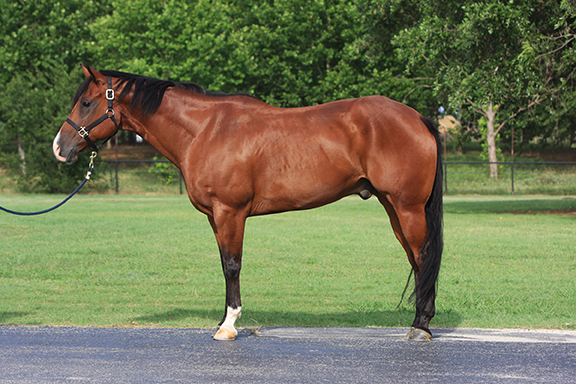
It may also be hard to keep weight on your horse. Many horses will have a lack of appetite and develop a ribby appearance. No matter how much sweet feed or hay you put in front of them, they will not fill out.
A very subtle sign to be aware of is the loss of sensation along the face, neck and/or body. Your horse may not respond to hand or leg pressure as he normally would. Tail swishing or skin twitching at flies will diminish, if not completely disappear.
NEURO EXAM
First, palpate the low back and sacrum area with your hands. You want your horse to flinch or drop away from the pressure. Many horses will turn and look at you as well. If your horse acts like he doesn’t feel the pressure this may be a sign of neurologic impairment.

Palpation of acupuncture meridians to look for painful responses can be helpful. Take a needle cap or pen and apply medium pressure running down along the lower part of the neck and then onto the chest. Next, brush the needle cap from the point of the hip up and back to the sacrum. Finally, run it down the middle of the hind leg down past the stifle. If you elicit painful twitching or your horse gives you a warning look upon palpation of the chest, hip or stifle, this may indicate immune and/or nervous system compromise.
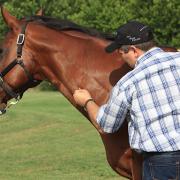
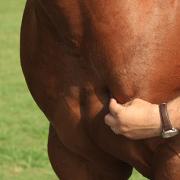
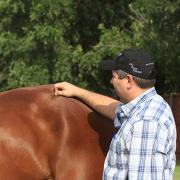
Take a piece of hay and lightly touch the side of the barrel in multiple areas. You are trying to mimic a fly walking on your horse. Also do this along the hip and stifle. Look for the skin to twitch to rid itself of the ‘poking’ from the hay piece. Check both sides, as there maybe asymmetrical dysfunction.
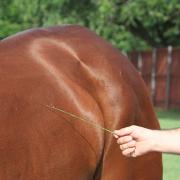
Move to the back of your horse, and grasp the tail about two hand widths down from the dock. Pull the tail up and poke the underside of the tail with your finger. Your horse should try to clamp its tail back down into a normal position. If it I easy to hold the tail up in the abnormal position, this is referred to as weak tail tone.

While standing next to a hind leg, facing the tail, pick up the near foot and place it away from you to cross in front of the off hind foot. If it takes longer than 5 seconds for your horse to bring its foot back into a correct square position, it flunks the placing test. Again, do this with both hind feet as sometimes the deficit is worse on one side than the other.
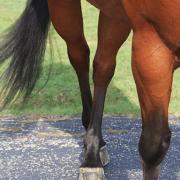
The final part of the exam is the sway test. While facing your horse, take the tail, and wrap it around your hand one time. Step to the side and draw the tail towards you, trying to pull your horse off balance. It is common that you will be able to do this the first time with little to no resistance. During the second attempt, your horse should resist you and lean against your pressure. If you find you can repeatedly pull your horse’s feet your direction, this demonstrates weakness in the hind end.

If your horse fails more than two of these tests, you need to have your veterinarian come out for a more thorough examination.

